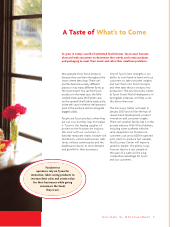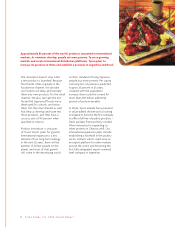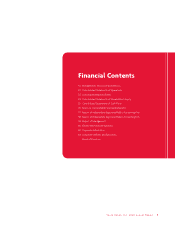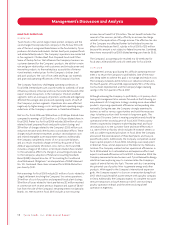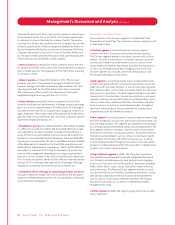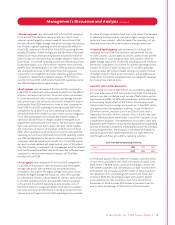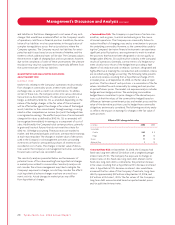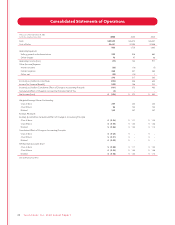Tyson Foods 2006 Annual Report Download - page 19
Download and view the complete annual report
Please find page 19 of the 2006 Tyson Foods annual report below. You can navigate through the pages in the report by either clicking on the pages listed below, or by using the keyword search tool below to find specific information within the annual report.
debt of outside third parties involving a lease, grower loans and
residual value guarantees covering certain operating leases for vari-
ous types of equipment. See Note 8, “Commitments” of the Notes
to Consolidated Financial Statements for further discussions of
these guarantees.
CONTRACTUAL OBLIGATIONS
The following table summarizes the Company’s contractual obliga-
tions as of September 30, 2006:
Payments Due by Period
2008– 2010– 2012 and
in millions 2007 2009 2011 thereafter Total
Debt and capital
lease obligations:
Principal
payments(1) $ 992 $ 454 $237 $2,296 $3,979
Interest
payments(2) 231 464 284 617 1,596
Guarantees(3) 54 74 27 34 189
Operating lease
obligations(4) 87 98 37 17 239
Purchase
obligations(5) 319 11 7 2 339
Capital
expenditures(6) 160 22 – – 182
Other long-term
liabilities(7) 4 8 7 43 62
Total contractual
commitments $1,847 $1,131 $599 $3,009 $6,586
(1) In the event of a default on payment or violation of debt covenants, acceleration of
the principal payments could occur. At September 30, 2006, the Company was in
compliance with all of its debt covenants.
(2) Interest payments include only interest payments on fixed-rate and fixed-term debt,
based on the expected payment dates. The Company has other interest obligations
on variable-rate, non-term debt; however, these obligations have been excluded, as
the timing of payments and expected interest rates cannot be estimated reasonably.
(3) Amounts included are for the guarantees of debt of outside third parties, which
involve a lease and grower loans, all of which are substantially collateralized by the
underlying assets, as well as residual value guarantees covering certain operating
leases for various types of equipment. The amounts included are the maximum
potential amount of future payments.
(4) Amounts included in operating lease obligations are minimum lease payments
under lease agreements.
(5) Amounts included in purchase obligations are agreements to purchase goods or
services that are enforceable and legally binding on the Company that specifies all
significant terms, including: fixed or minimum quantities to be purchased; fixed,
minimum or variable price provisions; and the approximate timing of the transac-
tion. The purchase obligations amount includes items such as future purchase
commitments for grains, livestock and natural gas contracts that provide terms that
meet the above criteria. The Company has excluded future purchase commitments
for contracts that do not meet these criteria. Purchase orders have not been included
in the table, as a purchase order is an authorization to purchase and is not consid-
ered an enforceable and legally binding contract. Contracts for goods or services
that contain termination clauses without penalty have also been excluded.
(6) Amounts included in capital expenditures are estimated amounts to complete
construction projects in progress as of September 30, 2006.
(7) Amounts included in other long-term liabilities are items that meet the definition of a
purchase obligation and are recorded in the Company’s Consolidated Balance Sheets.
RECENTLY ADOPTED ACCOUNTING STANDARDS
AND REGULATIONS
In December 2004, the FASB issued Statement of Financial Account-
ing Standards No. 123R, “Share-Based Payment” (SFAS No. 123R). The
pronouncement requires companies to measure and recognize
compensation expense for all share-based payments to employees,
including grants of employee stock options, restricted stock and
performance-based shares, in the financial statements based on the
fair value at the date of the grant. In the first quarter of fiscal 2006,
the Company adopted SFAS No. 123R using the modified prospec-
tive method. Under the modified prospective method, compensa-
tion cost is recognized for all share-based payments granted after
the adoption of SFAS No. 123R and for all awards granted to employees
prior to the adoption date of SFAS No. 123R and unvested on the
adoption date. Accordingly, no restatements were made to prior
periods. Prior to the adoption of SFAS No. 123R, the Company
applied Accounting Principles Board Opinion No. 25, “Accounting
for Stock Issued to Employees” in accounting for its employee stock
compensation plans. Accordingly, no compensation expense was
recognized for its stock option issuances as stock options are issued
with an exercise price equal to the closing price at the date of grant.
Also, prior to the adoption of SFAS No. 123R, the Company issued
restricted stock and recorded the fair value of such awards as deferred
compensation amortized over the vesting period. The fair value
of each option grant is established on the date of grant using the
Black-Scholes option-pricing model for grants awarded prior to
October 1, 2005, and a binomial lattice method for grants awarded
subsequent to October 1, 2005. The change to the binomial lattice
method was made to better reflect the exercise behavior of top
management. The Company recognized compensation expense (net
of tax) of $9 million and $15 million in fiscal 2006 related to stock
options and restricted stock, respectively. As of September 30,
2006, the Company had $38 million of total unrecognized compen-
sation cost related to stock option plans that will be recognized
over a weighted average period of 2.2 years and $42 million of total
unrecognized compensation cost related to restricted stock awards
that will be recognized over a weighted-average period of 1.5 years.
In March 2005, the FASB issued Interpretation No. 47, “Accounting
for Conditional Asset Retirement Obligations,” an interpretation of
FASB Statement No. 143 (FIN 47). Statement of Financial Accounting
Standards No. 143, “Accounting for Asset Retirement Obligations”
(SFAS No. 143), was issued in June 2001 and requires an entity to
recognize the fair value of a liability for an asset retirement obliga-
tion in the period in which it is incurred if a reasonable estimate of
fair value can be made. SFAS No. 143 applies to legal obligations
associated with the retirement of a tangible long-lived asset that
resulted from the acquisition, construction, development and/or
the normal operation of a long-lived asset. The associated asset
costs are capitalized as part of the carrying amount of the long-
lived asset. FIN 47 clarifies the term “conditional asset retirement
obligation” as used in SFAS No. 143, refers to a legal obligation to
perform an asset retirement activity in which the timing and/or
method of settlement are conditional on a future event that may
or may not be within the control of the entity. FIN 47 requires an
entity to recognize a liability for the fair value of a conditional asset
Ty s on Foods, Inc. 2006 Annual Report17
Management’s Discussion and Analysiscontinued


